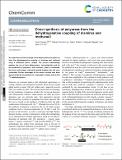Files in this item
Direct synthesis of polyureas from the dehydrogenative coupling of diamines and methanol
Item metadata
| dc.contributor.author | Kumar, Amit | |
| dc.contributor.author | Armstrong, Daniel | |
| dc.contributor.author | Peters, Gavin | |
| dc.contributor.author | Nagala, Manjula | |
| dc.contributor.author | Shirran, Sally Lorna | |
| dc.date.accessioned | 2021-05-28T15:30:20Z | |
| dc.date.available | 2021-05-28T15:30:20Z | |
| dc.date.issued | 2021-06-25 | |
| dc.identifier | 274299368 | |
| dc.identifier | 4c6d1a7e-442d-46f3-b3e3-b25ab0498372 | |
| dc.identifier | 000655117200001 | |
| dc.identifier | 85108668930 | |
| dc.identifier.citation | Kumar , A , Armstrong , D , Peters , G , Nagala , M & Shirran , S L 2021 , ' Direct synthesis of polyureas from the dehydrogenative coupling of diamines and methanol ' , Chemical Communications , vol. 57 , no. 50 , pp. 6153-6156 . https://doi.org/10.1039/D1CC01121A | en |
| dc.identifier.issn | 1359-7345 | |
| dc.identifier.other | ORCID: /0000-0003-3516-3507/work/94291572 | |
| dc.identifier.other | ORCID: /0000-0002-8175-8221/work/94291749 | |
| dc.identifier.uri | https://hdl.handle.net/10023/23272 | |
| dc.description | AK thanks the Leverhulme Trust for an early career fellowship. | en |
| dc.description.abstract | We report here the first example of the direct synthesis of polyureas from the dehydrogenative coupling of diamines and methanol using a ruthenium pincer catalyst. The present methodology replaces the use of toxic diisocyanates, conventionally used for the production of polyureas, with methanol, which is renewable, less toxic, and cheaper, making the overall process safer and more sustainable. Further advantages of the current method have been demonstrated by the synthesis of a renewable, a chiral, and the first 13C-labelled polyurea. | |
| dc.format.extent | 4 | |
| dc.format.extent | 1780902 | |
| dc.language.iso | eng | |
| dc.relation.ispartof | Chemical Communications | en |
| dc.subject | QD Chemistry | en |
| dc.subject | NDAS | en |
| dc.subject | SDG 7 - Affordable and Clean Energy | en |
| dc.subject.lcc | QD | en |
| dc.title | Direct synthesis of polyureas from the dehydrogenative coupling of diamines and methanol | en |
| dc.type | Journal article | en |
| dc.contributor.sponsor | The Leverhulme Trust | en |
| dc.contributor.institution | University of St Andrews. School of Chemistry | en |
| dc.contributor.institution | University of St Andrews. School of Biology | en |
| dc.contributor.institution | University of St Andrews. Biomedical Sciences Research Complex | en |
| dc.identifier.doi | 10.1039/D1CC01121A | |
| dc.description.status | Peer reviewed | en |
| dc.identifier.grantnumber | ECF-2019-161 | en |
This item appears in the following Collection(s)
Items in the St Andrews Research Repository are protected by copyright, with all rights reserved, unless otherwise indicated.

